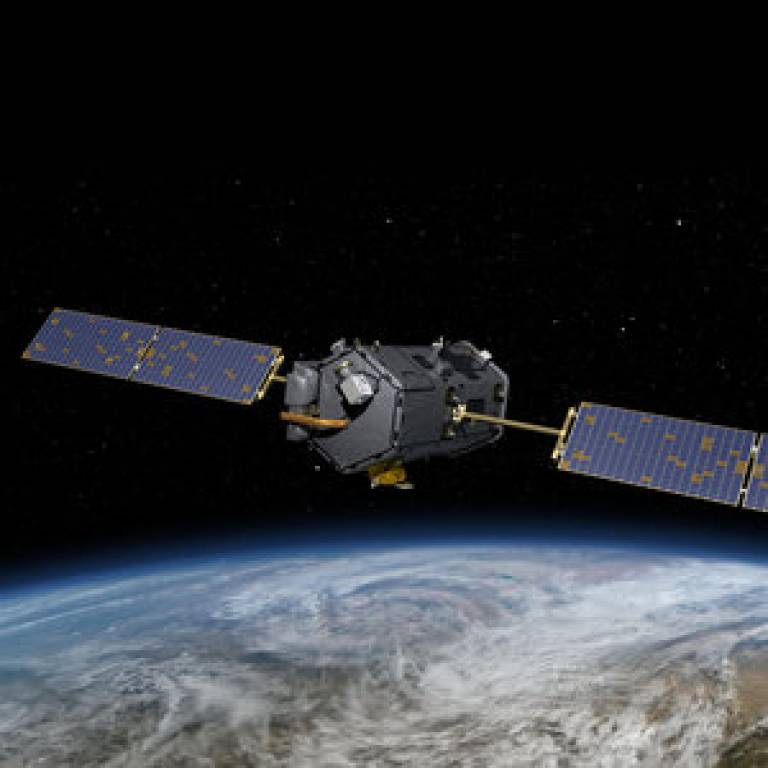New calculations to improve carbon dioxide monitoring from space
15 June 2015
How light of different colours is absorbed by carbon dioxide (CO2) can now be accurately predicted using new calculations developed by a UCL-led team of scientists.
 This will help climate scientists
studying Earth's greenhouse gas emissions to better interpret data collected
from satellites and ground stations measuring CO2.
This will help climate scientists
studying Earth's greenhouse gas emissions to better interpret data collected
from satellites and ground stations measuring CO2.
By improving the understanding of how much radiation CO2 absorbs, uncertainties in modelling climate change will be reduced and more accurate predictions can be made about how much Earth is likely to warm over the next few decades.
Previous methods were only accurate to about 5% at best across all wavelengths, whereas the new calculations give an accuracy of 0.3%. This improvement will enable missions to achieve their goals, which demand an accuracy of 0.3-0.5% say the team of scientists.
The study, published today in Physical Review Letters by researchers from UCL, the Russian Academy of Sciences (Russia), National Institute of Standards and Technology (USA) and Nicolaus Copernicus University (Poland), shows how the fundamental laws of quantum mechanics can be used to predict precisely how light of different colours is absorbed by CO2. This will help climate scientists work out how CO2 evolves in the atmosphere and pinpoint where it is being produced.
Billions of dollars are currently being spent on satellites that monitor what seems to be the inexorable growth of CO2 in our atmospheres. To interpret their results, however, it is necessary to have a very precise answer the question "How much radiation does one molecule of CO2 absorb?"
Professor Jonathan Tennyson
Supervising author, Professor Jonathan Tennyson, UCL Physics & Astronomy, said: "Billions of dollars are currently being spent on satellites that monitor what seems to be the inexorable growth of CO2 in our atmospheres. To interpret their results, however, it is necessary to have a very precise answer the question "How much radiation does one molecule of CO2 absorb?" Up until now laboratory measurements have struggled to answer this question accurately enough to allow climate scientists to interpret their results with the detail their observations require."
The team used calculations based on quantum mechanical equations to predict the chances of a CO2 molecule absorbing different colours of light, which have defined energies. These predictions, made using powerful computers, were verified using highly precise measurements taken using an extremely sensitive technique called 'cavity-ring down spectroscopy'. This method simulates the distances in space across which absorption measurements are taken, but in a sample length of 75 cm.
Lead author, Dr Oleg Polyansky, UCL Physics & Astronomy, said: "We have long known the exact quantum mechanical equations obeyed by a molecule like CO2; however these equations are much too complicated to solve explicitly. But the combination of modern computers and novel treatments of the problem mean that we can now use quantum theory to calculate how strongly CO2 absorbs light at each wavelength."
Dr Joseph Hodges, from the National Institute of Science and Technology in Gaithersberg, USA who led the team measuring the spectrum of CO2 in the laboratory, said: "These measurements are very challenging so we could only make precise lab measurements at a few wavelengths. Where we were able to make measurements, the agreement with the calculations is excellent which enables us to have full confidence in Dr Polyansky's calculations."
The results will allow atmospheric scientists to monitor how CO2 evolves in Earth's atmosphere, where is produced and moves to, all of which are key to understanding the atmosphere, monitoring human behaviour and the future of our planet.
Links
- Dr Oleg Polyansky's academic profile on Iris
- Professor Jonathan Tennyson's academic profile on Iris
- UCL Physics & Astronomy
- UCL Mathematical & Physical Sciences
Image
- NASA's OCO-2 satellite launched last year measuring the CO2 content of Earth's atmosphere from space. The results of OCO-2 and other satellite missions will be much more accurate as a result of the new calculations. (Credit: NASA)
Media contact
Bex Caygill
Tel: +44 (0)20 3108 3846
Email: r.caygill [at] ucl.ac.uk
 Close
Close

